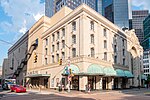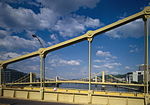Fulton Building
1906 establishments in PennsylvaniaCommercial buildings completed in 1906Commercial buildings in PittsburghCommercial buildings on the National Register of Historic Places in PennsylvaniaNational Register of Historic Places in Pittsburgh ... and 1 more
Pittsburgh History & Landmarks Foundation Historic Landmarks

The Fulton Building is a structure in Pittsburgh, Pennsylvania. The building was completed 1906 and was designed by architect Grosvenor Atterbury. Construction was funded by industrialist Henry Phipps, and the name of the building is a tribute to noted inventor Robert Fulton.[1] It was listed on the National Register of Historic Places in 2002. On May 26, 1943 the building hosted America's first night-court for gasoline war ration violators. Since 2001, it has been the home of the city's Renaissance Hotel.
Excerpt from the Wikipedia article Fulton Building (License: CC BY-SA 3.0, Authors, Images).Fulton Building
6th Street, Pittsburgh
Geographical coordinates (GPS) Address Nearby Places Show on map
Geographical coordinates (GPS)
| Latitude | Longitude |
|---|---|
| N 40.4438 ° | E -80.0023 ° |
Address
Braddock's American Brasserie
6th Street
15222 Pittsburgh
Pennsylvania, United States
Open on Google Maps










